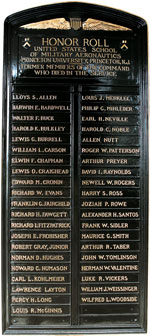
By the numbers
School of Military Aeronautics

In 1917, during the height of World War I, the U.S. Army asked Princeton and several other private universities to host a School of Military Aeronautics to educate cadets in aeronautics and engineering prior to flight training.
Interest in the little-known program at Princeton was revived in 2006 when Richard Smith, a member of the Princetoniana Committee and a senior technical assistant in the Department of Ecology and Evolutionary Biology, found a plaque in the basement of Nassau Hall commemorating alumni of the school who were killed during the war. Last fall the plaque was restored and hung at the Army ROTC headquarters at 294 Alexander St.
- Students in the program attended a four-week “ground school” before attending stateside and overseas flight schools. Subjects taught by University instructors included “Aeronautical Motors,” “Theory of Flight,” “Cross Country and General Flying,” “Aerial Observation,” “Gunnery,” “Signaling and Radio,” “Infantry Drill” and “Calisthenics.” Princeton was one of eight universities to host such a program.
- Princeton students were among those enrolled in the program. The first cadre had a total of 29 attendees, but by the war’s end, thousands of cadets had attended the school.
- Classes were held in Guyot Hall and the former Palmer Physical Laboratory (now Frist Campus Center). The last class was held Nov. 23, 1918.
- The plaque at the Army ROTC headquarters bears the name of 41 School of Military Aeronautics graduates who were killed in action, including six who were Princeton students or alumni.
- The plaque originally was displayed in Memorial Hall in Nassau Hall, but at some point it was moved to the basement for storage. The plaque was restored and put back on display in September 2008. In addition to Smith, the project was spearheaded by retired Army Col. Paul Miles, a lecturer in history; Lt. Col. John Stark, who teaches military science for the Princeton Army ROTC; Steve Virostko, project manager in the Office of Design and Construction; and John Weeren, assistant to the president and speechwriter.
- A new companion plaque honoring the six Princeton students or alumni killed in action recently was made. It also is on display at 294 Alexander St.

